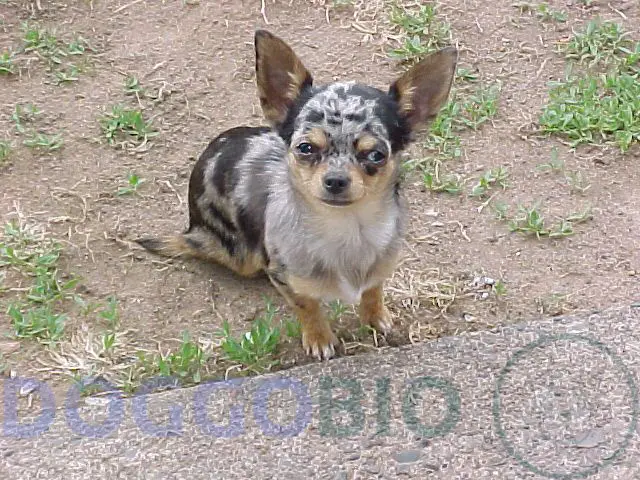Welcome to the enchanting world of the Blue Merle Chihuahua! With their mesmerizing coat patterns and endearing personalities, these tiny yet mighty canines have captured the hearts of dog lovers everywhere.
The Blue Merle Chihuahua is a unique and rare variation of the beloved Chihuahua breed, known for their striking blue and gray marbled coats, speckled with splashes of black, white, and tan. Beyond their exquisite appearance, these pint-sized pooches are brimming with charm, intelligence, and loyalty.
Whether you are captivated by their stunning aesthetics or are intrigued by their delightful temperament, join us as we delve into the captivating world of this dog breed and uncover the many reasons why they are adored by dog enthusiasts worldwide.
A Brief Overview of Blue Merle Chihuahua
| Breed | Blue Merle Chihuahua |
| Appearance | Medium-length coat with swirls of gray, blue, and tan (“marbled”) * Coat can be smooth or longhaired * Distinctive blue eyes, though brown or amber eyes are also possible |
| Temperament | Affectionate and loyal companion dog * Lively and energetic despite small size * Can be territorial and defensive towards strangers, but proper socialization is key |
| Size | Standard (5-8 lbs) or Teacup (1-3 lbs) varieties |
| Lifespan | 12-16 years on average |
| Health | Prone to certain health issues associated with the merle gene, including deafness, blindness, and eye problems |
| Activity Level | High energy level, requires regular exercise and playtime |
| Recognize | Not recognized by all major kennel clubs due to health concerns associated with the merle gene |
| Suitability for | Active individuals or families who can provide plenty of love, attention, and exercise |
| Not suitable for | Families with small children or other pets, as they can be easily injured due to their small size |
What is Blue Merle Chihuahua?
A Blue Merle Chihuahua is a type of Chihuahua with a faded black or greyish-blue coat pattern mottled on a lighter background.

It is important to note that Merle is not a color but a pattern caused by the Merle gene. This pattern, called “dapple” or “mottle,” appears as dark patches or spots on the dog’s coat.
Interesting Facts about Blue Merle Chihuahuas

1.They Didn’t Exist 20 Years Ago.
They emerged relatively recently. Traditionally, Chihuahuas were found in solid, bi-colored, and tri-colored coats.
2.The Blue Merle Gene Not Only Affects Hair Color But Also Influences Akin Pigmentation.
This means the pattern remains visible on the Chihuahua even if fully shaved.
3.They Have Unique Eyes
Blue Merle Chihuahuas may have blue eyes, which adds to their uniqueness since blue is not a natural eye color for Chihuahuas.
Not all them have the same eye color. Some exhibit heterochromia, meaning they may have one blue eye and one dark brown eye.
4.Ethical Controversies In Genetics
Blue Merle Chihuahuas are not considered purebred since the Merle gene naturally occurs in larger dog breeds. Experts believe that Chihuahuas acquired this gene through crossbreeding.
Breeding two Blue Merle Chihuahuas together is strongly discouraged even if they are unrelated. There is a high probability of the resulting puppies being born with defects or health issues.
Some Chihuahuas can carry the Blue Merle gene without displaying the characteristic pattern. These Chihuahuas, known as phantom merles, appear like regular Chihuahuas despite having the blue merle gene.
Not all them are ethically bred. Some breeders attempt to produce puppies by breeding two Blue Merle Chihuahuas together, often leading to puppies with deafness or blindness.
5.They Are Very Expensive
They can come with a significant price tag due to their high demand. The average cost of a Blue Merle Chihuahua is around $1,500, although some can be priced as high as $10,000.
6.Temperament Of Them
They possess the same temperament and behavior traits as regular Chihuahuas despite their unique appearance. They are bold, loud, loyal, and protective companions.
How to Care for Your Chihuahua?
Here are essential care guidelines for your Blue Merle Chihuahua:

1.Reduce Them From The Sun
Blue Merle Chihuahuas have light and sensitive skin that offers limited protection against solar radiation, increasing their risk of skin cancer. It’s crucial to minimize sun exposure and avoid intense sunlight.
Additionally, be mindful that Blue Merle Chihuahuas with blue eyes are highly sensitive to bright light, which can lead to blindness.
2.Get Health Insurance
Health insurance is essential for all Chihuahuas, in particular, are more susceptible to health issues.
Having reliable pet insurance helps manage medical expenses and ensures that your puppy receives the necessary care.
3.Early Socializa
Early socialization and training are crucial. They need to learn social skills at a young age, especially if they have hearing or vision impairments.
Chihuahuas’ bold nature makes proper training essential. Start training them during puppyhood for a well-behaved companion.
4.Seek Advice From Your Vet
Many Blue Merle Chihuahuas may be blind, deaf, or both. However, this doesn’t diminish their capacity for love.
With proper care and expert medical advice, even a blind or deaf dog can provide you with tremendous affection.
Consulting your veterinarian will help you navigate the unique care requirements and ensure the well-being of your beloved companion.
Food and Diet
Regarding food and nutrition, Blue Merle Chihuahuas have similar dietary needs to regular Chihuahuas. Feeding them low-fat meals twice a day is recommended to maintain their energy levels and stabilize their blood sugar.
Providing a balanced diet that meets their nutritional requirements is crucial for the overall health and well-being of them, just like any other Chihuahua. Consulting with a veterinarian can help determine the specific dietary needs of your dog based on their age, weight, and any specific health considerations.
Life Expectancy and Common Health Issues

Blue Merle Chihuahuas are prone to several health problems, including:
- Deafness: Deafness is more common in Blue Merle Chihuahuas than in any other breed. This is because the Merle gene affects the pigmentation inside the ears, leading to the accelerated degeneration of nerve endings and hearing loss.
- Blindness: Blue Merle Chihuahuas have a higher likelihood of being born blind or developing blindness over time. The reduced pigmentation inside their eyes makes them sensitive to bright light. Protecting them from the sun is essential by providing shade on bright sunny days.
- Skin cancer: The loss of pigmentation caused by the Blue Merle gene exposes certain areas of the Chihuahua’s body to increased UV ray exposure, which raises the risk of skin cancer.
- Color Dilution Alopecia: Blue Merle Chihuahuas with lighter-colored hair are susceptible to Color Dilution Alopecia (CDA). This condition leads to the appearance of bald patches and can be accompanied by itchy or flaky skin, as well as other infections.
- Microphthalmia: They may be born with malformed or uneven eyes, known as microphthalmia. This can result in partial or complete blindness.
It is essential to be aware of these health issues and provide appropriate care and attention to puppies to ensure their well-being.
How Much Is A Blue Merle Chihuahua?
On average, Blue Merle Chihuahuas are sold for around $1,500. However, it is important to note that prices can vary, and in some cases, they may even reach as high as $10,000.
A Blue Merle Chihuahua’s cost depends on factors such as lineage, pedigree, coat quality, and breeder reputation.
Is A Blue Merle Chihuahua The Right Dog for You?
If you are considering a Blue Merle Chihuahua, it’s important to carefully evaluate whether they are the right fit for you. Blue Merle Chihuahuas, like any other Chihuahua, can make loyal, brave, and loving pets. However, there are a few key factors to consider.
- First and foremost, it’s essential to understand that these delicate little dogs require special care and attention. They are prone to disabilities, such as deafness, blindness, and other health issues. Being prepared to provide the necessary support and accommodations is crucial.
- Additionally, it’s worth noting that most kennel clubs do not officially recognize Blue Merle Chihuahuas. The American Kennel Club (AKC) does allow their registration but under specific conditions. Therefore, if having a formally recognized breed is important to you, this is something to consider.
- Furthermore, ensuring that the dog you choose comes from ethical breeding practices is vital. Ethical breeders prioritize the health and well-being of the dogs and provide proper documentation to establish the dog’s lineage and health history.
By carefully considering these factors and evaluating your ability to meet the needs of a Blue Merle Chihuahua, you can make an informed decision about whether this unique and special dog is the right companion for you.
Frequently Asked Questions
Does AKC Recognize Blue Merle Chihuahua?
According to the American Kennel Club (AKC), the primary Kennel Club, Blue Merle Chihuahuas, can be registered.
However, the AKC has specific requirements for registration. The Chihuahua must be healthy, free from diseases, and ethically bred.
These guidelines ensure that the registered Blue Merle Chihuahuas meet specific standards of health and well-being.
Are Blue Merle Chihuahua Rare?
No. A Blue Merle Chihuahua is not considered rare. Although this coat variation is relatively new, it is not uncommon.
The merle gene is not recessive, so when a merle Chihuahua breeds with any other Chihuahua, at least one offspring will likely be a merle. While there are different Merle colors, the Blue Merle Chihuahua is the least rare among them.
Do Blue Merle Chihuahuas Require Additional Attention?
Yes. Blue Merle Chihuahuas indeed require additional attention. They have a heightened sensitivity to bright light and sun, necessitating extra care compared to other dogs.
When exposed to prolonged periods of bright light and sun, They may experience excessive tearing in their eyes, giving the appearance of tears or imminent crying. Therefore, it is crucial to be mindful of their exposure to sunlight and take appropriate measures to protect their eyes.
Is Blue Merle A Natural Color In Chihuahuas?
No. Blue Merle is not a natural color in Chihuahuas.
Although Chihuahuas come in various coat colors and patterns, Blue Merle is not among the natural color variations. Surprisingly, Blue Merle Chihuahuas were virtually non-existent until a few decades ago.
It is believed that the gene responsible for the Blue Merle coat pattern was introduced through crossbreeding.
Conclusion
In conclusion, the Blue Merle Chihuahua stands as a captivating and remarkable breed within the canine kingdom. Their unique coat patterns, combining shades of blue, gray, black, white, and tan, make them a true visual spectacle. However, their allure goes far beyond their striking appearance. These little dogs possess intelligence, loyalty, and a spirited personality that charms all who cross their path.
Whether as a cherished companion or a beloved show dog, the Blue Merle Chihuahua leaves an indelible mark on the hearts of those fortunate enough to experience their presence. With their unwavering devotion and irresistible charm, it’s no wonder they have become treasured companions in countless households around the world.
So, if you find yourself captivated by their beauty and intrigued by their endearing nature, welcome the Blue Merle Chihuahua into your life and prepare to embark on a journey of boundless love and joy.
Schema:
Hi there to all, for the reason that I am genuinely keen of reading this website’s post to be updated on a regular basis. It carries pleasant stuff.